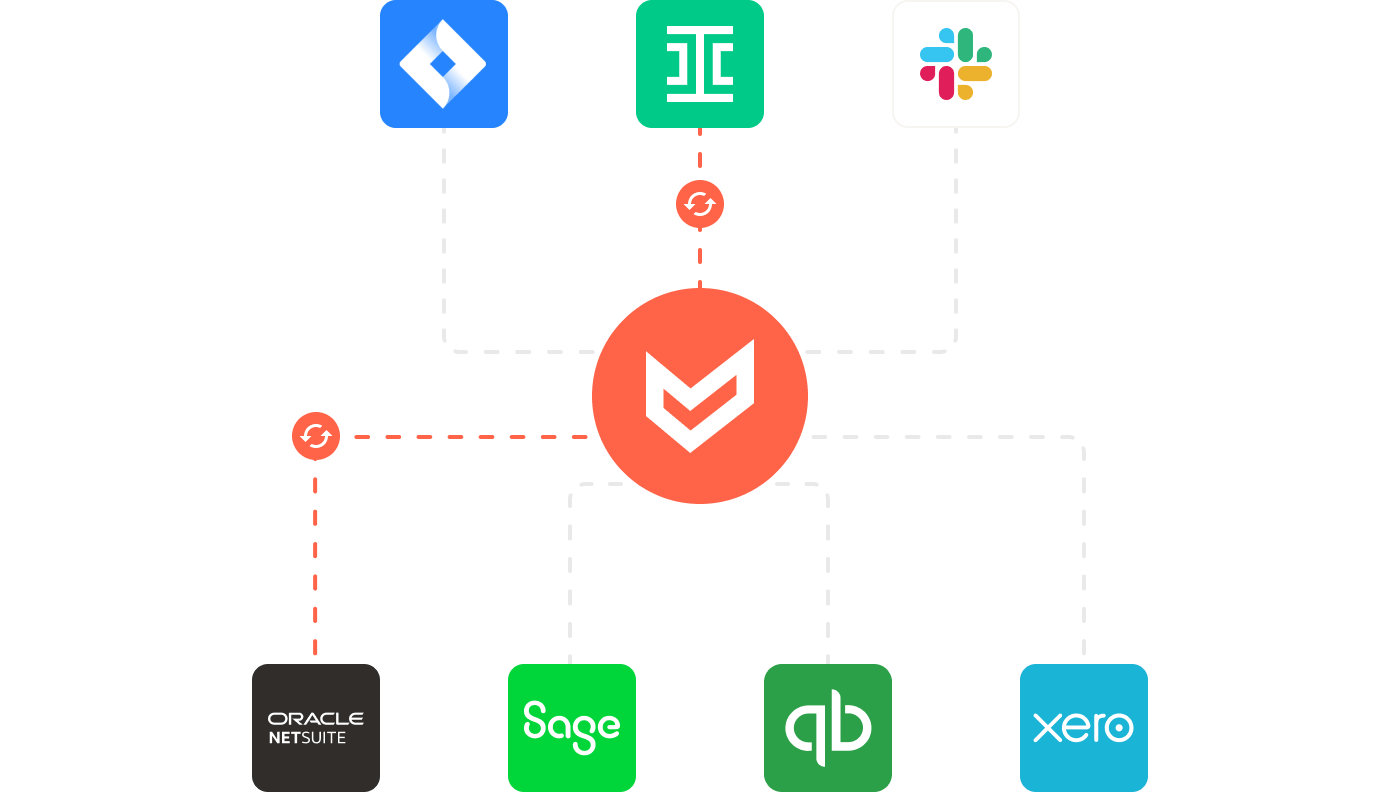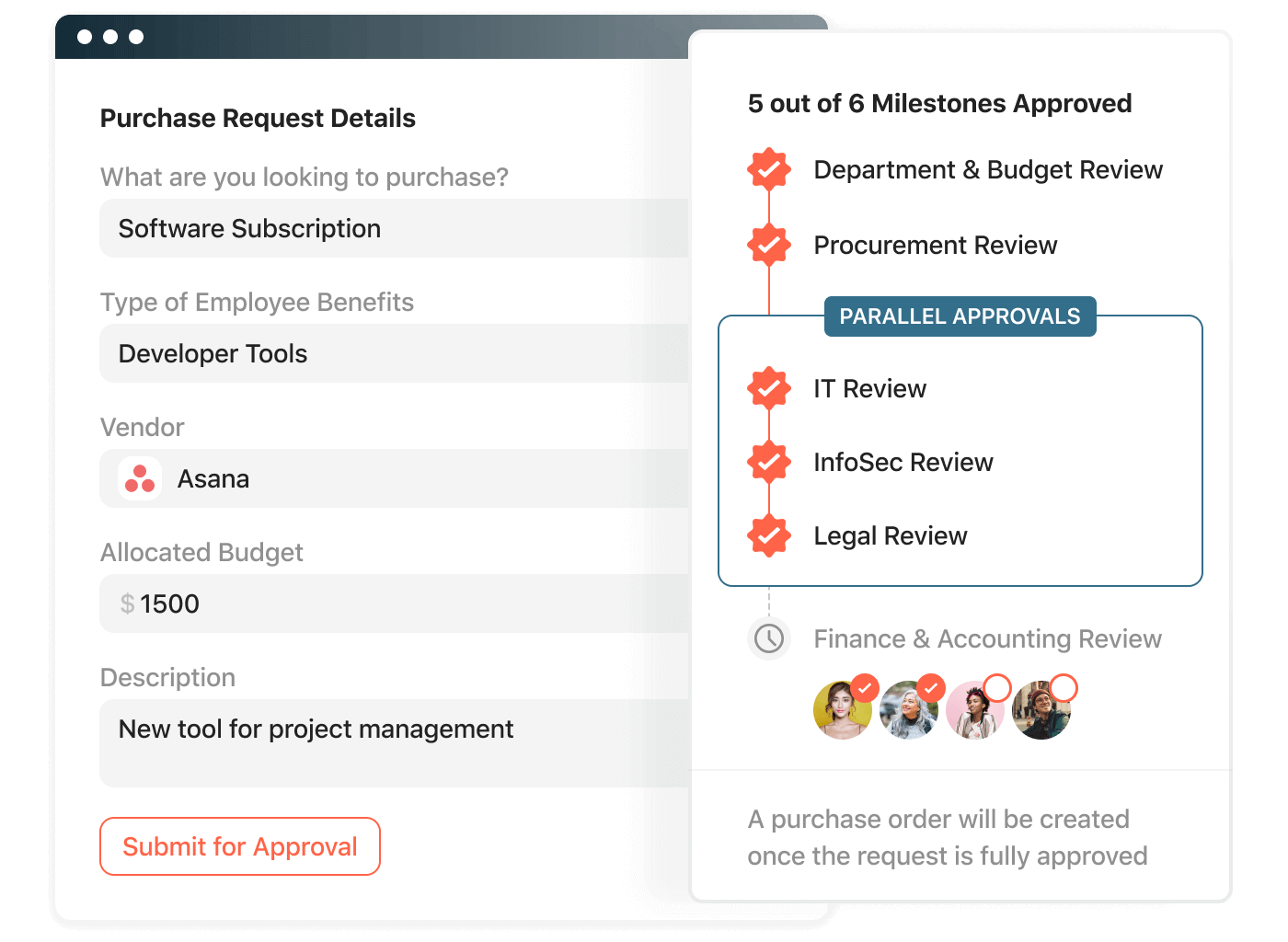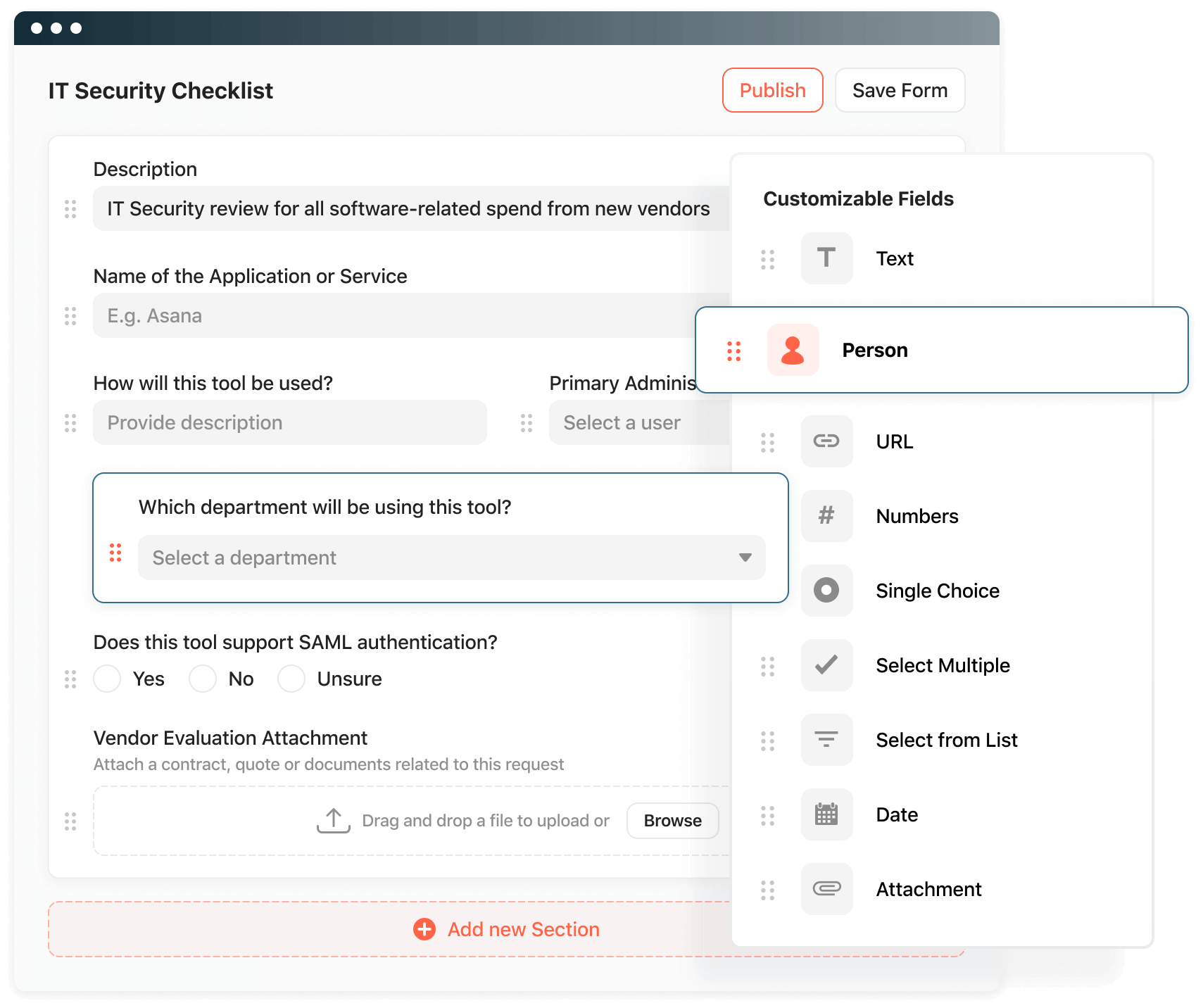PROCUREMENT MANAGEMENT SOFTWARE
Airbase’s intake module, called Guided Procurement, is oh-so-easy to use.
- Gain real-time visibility and control over procure-to-pay processes.
- Ensure employee adoption to drive maximum value.
- Automate procurement processes and tracking to maximize efficiency.


Spend orchestration for all stakeholders.
Airbase serves as a single front door for all employee spend and routes requests to all required stakeholders. Airbase integrates with the business systems they already use, like Jira, Docusign, Ironclad, and more, to support cross-functional operations.

“In just a few months from implementation, we tripled our percentage of spend under management, which is an important goal for me as a Procurement leader. The module takes approvals so much further by including all stakeholders in the process — it’s a real upgrade to our internal controls. Guided Procurement incorporates everything I need — risk review, privacy review, info security review, and approval review with automatic routing for all relevant purchases.“
Christina Howlett Perez
Associate VP, Procurement at Definitive Healthcare

A delightful experience = great employee adoption.
Eliminate the confusion and friction for employees. Airbase directs employees to gather the right information and documentation needed by various stakeholders like IT, procurement, and legal so that all necessary approvals are secured before a purchase is made.


Flexible, no-code approval workflows.
Our dynamic, easily adjusted workflows offer flexibility to govern different types of spend. Enforce your company policies and route every transaction to the right teams at the right time. Empower your procurement team to focus on strategic spend, shorten cycle times, and give them oversight of all purchases.
Manage renewals with ease.
Uncover cost-saving opportunities with early visibility into all upcoming renewals. Ensure 100% of renewals are covered so procurement and stakeholder teams can proactively plan, assess, and negotiate new deals with current suppliers.

Let the system enforce compliance.
Take the risk out of your accounts payable. All teams — procurement, legal, IT, etc. — get real-time control over spend and vendors. Automatically capture information and documentation required for compliance before a purchase can be made.
Easily build vendor questionnaires to get the answers and documentation that all stakeholders need in the approval process. Information submitted by the vendor will seamlessly flow to the relevant stakeholders for review and approval.


“Guided Procurement gives employees an easy way to gather necessary information for every purchase and route it automatically to all stakeholders, directly to the software they already use. Everyone involved, from the requestor to the stakeholders, gets a great user experience, and we get improved compliance, speed, and visibility to find more savings.”
Erin Marchbanks
Accounts Payable Manager at Recharge

IDC ANALYST SPOTLIGHT REPORT
IDC urges better adoption and compliance by turning to Guided Procurement software.
Guided Procurement succeeds because of its user-centric approach.

Visibility and control for all business groups.
Guide employees.
Empower employees with an automated procurement process. Make it easy to request and get approvals for spend.
Enforce compliance.
Control risk with a centralized procurement process that ensures employees meet every department’s compliance policies.
Visibility for every stakeholder.
Get complete and real-time visibility into all the steps of the purchasing process within one consistent workflow.
Seamless integrations.
Unite stakeholders, processes, and approvals in a collaborative workflow that integrates with each of your business units’ systems.
Procurement/ Intake FAQs
What is procurement?
Procurement is a broad term that refers to the process of acquiring goods and services from external sources to meet an organization’s needs. It involves the identification of requirements, supplier selection, negotiation, and purchase of goods or services.
The scope of a Procurement department varies widely depending on the type of industry. The procurement needs of a manufacturing company, for example, are typically much more complex, involving regular RFPs and more fulfillment criteria than for a SaaS company.
Procurement aims to ensure that the organization obtains the right quality and quantity of goods or services at the most favorable price and within specified timelines. Depending on a company’s needs, this could involve activities such as sourcing suppliers, managing contracts, conducting market research, evaluating supplier performance, and maintaining good relationships with vendors.
Why should I use procurement software?
For some types of businesses, procurement software is essential to operations. But no matter how extensive an organization’s procurement needs are, procurement software offers several benefits:
- It provides a platform for multi-stakeholder collaboration on information and documentation sharing and approval workflows.
- It automates and streamlines the procurement process, reducing manual tasks, paperwork, and errors.
- It improves efficiency by providing a centralized platform for managing requisitions, purchase orders, and supplier information.
- Procurement software enhances visibility into procurement activities, allowing organizations to track spending, monitor supplier performance, and enforce compliance.
- It helps optimize sourcing decisions by facilitating supplier selection, negotiation, and contract management.
- Procurement software gives better cost control, identifies cost-saving opportunities, and enhances financial management.
- It enhances communication with suppliers and facilitates timely delivery of goods or services.
How can I choose the best procurement software for my business?
When choosing the best procurement software for your business, start by assessing your organization’s specific procurement needs, considering factors like scalability, functionality, and ease of use.
Identify the key features required, such as requisition management, supplier management, contract management, and reporting capabilities.
Evaluate the software’s integration capabilities with existing business systems and compatibility with your workflows.
Consider the vendor’s reputation, customer support, and implementation process.
Request demos or trials to test usability and engage with references or reviews for insights. Compare pricing models and the total cost of ownership.
Ultimately, you should select a solution that aligns with your business goals, offers scalability, and provides a user-friendly experience with strong vendor support.
How do procurement needs vary by business?
Procurement needs vary by business due to several factors.
The industry a business operates in plays a crucial role. For example, a manufacturing company requires raw materials and machinery, while a service-based company may focus more on procuring software licenses or professional services.
The size and scale is also a factor. Larger organizations often have complex supply chains and bulk purchasing requirements, whereas smaller businesses may prioritize cost-effectiveness and flexibility.
Geographical location and global presence impact procurement needs, with international businesses needing to navigate cross-border trade and diverse regulations.
Ultimately, each business’s unique goals, strategies, and operational requirements shape its specific procurement needs.
What are the steps in procurement?
Procurement typically involves several stages or steps. These stages may vary depending on the organization and the complexity of the procurement process. However, the common procurement stages include:
- Need Identification: Recognizing the requirement for goods or services.
- Planning: Defining the procurement strategy, specifications, and budget.
- Vendor selection: Identifying potential suppliers and inviting proposals or quotes.
- Evaluation and Selection: Assessing supplier responses, negotiating terms, and choosing the preferred supplier.
- Contracting: Finalizing contractual agreements, including terms and conditions.
- Order Fulfillment: Receiving and inspecting the delivered goods or services.
- Invoice Processing and Payment: Verifying supplier invoices, ensuring compliance, and initiating timely payment.
Effective management of these stages ensures a smooth and efficient procurement process.
What is the difference between procure-to-pay, source-to-pay, and spend management?
Procure-to-pay (P2P) refers to the procurement process, starting from requisitioning goods or services to paying suppliers. It covers activities like purchase requisition, supplier selection, PO generation, goods receipt, invoice processing, and payment.
Source-to-pay (S2P) is a broader concept that encompasses strategic sourcing, supplier management, contract management, and P2P. It focuses on optimizing the end-to-end procurement process, from sourcing suppliers to payment.
Spend management refers to the holistic approach of managing an organization’s spend across various categories, including direct and indirect expenses. Spend management aims to control costs, improve supplier relationships, and drive efficiency. It does not typically support S2P activities.
What is the difference between procurement and purchasing?
Procurement and purchasing are distinct yet interconnected concepts within the realm of business operations.
Procurement refers to the process of acquiring goods and services, encompassing activities like supplier selection, negotiation, and contract management.
Purchasing, on the other hand, specifically relates to the act of buying goods or services. It is a subset of the broader procurement process, focusing on the transactional aspect of obtaining products.
What is spend under management?
Spend under management refers to the portion of an organization’s total spend that is actively monitored, controlled, and managed through strategic procurement practices. It represents the amount of money that is subject to procurement policies, supplier negotiations, and ongoing management efforts.
This includes expenditures that are tracked, analyzed, and optimized to achieve cost savings, increase efficiency, and improve supplier relationships.
By focusing on spend under management, organizations can gain better visibility into their spending, implement effective procurement strategies, consolidate purchasing power, negotiate favorable contracts, and drive value across their supply chain.
Spend under management is therefore a key metric in assessing the effectiveness of procurement efforts and cost control initiatives.
Is procure-to-pay (P2P) software designed for mid-market companies?
P2P software was designed for the needs of enterprise-level companies, especially ones with ongoing inventory needs and supplier and supply chain management requirements.
Traditional P2P software is highly customizable so that it can be implemented to meet the specific needs of a company’s procurement operations. As such, implementation tends to take six months to a year and generally involves heavy change management efforts.
These systems are designed to support complex supply management processes and a range of stakeholders involved in sourcing and inventory management. They are not considered to be highly user-friendly for those that aren’t regular users.
These systems are expensive for mid-market companies and are typically only adopted where a company has heavy supplier and inventory management requirements.
What is P2P?
P2P refers to a business process encompassing the entire procurement cycle, from requisitioning goods or services to making payments to suppliers.
P2P incorporates a series of steps, starting with the identification of procurement needs, vendor selection, and negotiation of terms. Once a purchase is approved, a purchase order (PO) is generated, goods are received, and invoices are processed.
The final stage involves verifying that a supplier has fulfilled all contract requirements, and reconciling invoices with POs and receipts, followed by payment to the supplier.
What is P2P software?
P2P software refers to integrated solutions that automate the end-to-end process of requesting, procuring, receiving, and paying for goods and services within an organization.
Key components include purchasing functionality, approval workflows converting requisitions into POs, transmission of POs to suppliers via email, portals, EDI, or XML, and receipt handling on mobile devices, desktops, or docks.
Accounts payable invoice automation captures and automates invoices, matching against POs, supporting coding and approval, and managing exceptions.
Learn how to get control over your spending.

 Jira
Jira  Ironclad
Ironclad  Asana
Asana 